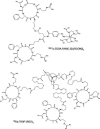Radiolabeled Peptides and Antibodies in Medicine
- PMID: 33325685
- PMCID: PMC7872318
- DOI: 10.1021/acs.bioconjchem.0c00617
Radiolabeled Peptides and Antibodies in Medicine
Abstract
Radiolabeled peptides are a relatively new, very specific radiotracer group, which is still expanding. This group is very diverse in terms of peptide size. It contains very small structures containing several amino acids and whole antibodies. Moreover, radiolabeled peptides are diverse in terms of the binding aim and therapeutic or diagnostic applications. The majority of this class of radiotracers is utilized in oncology, where the same structure can be used in therapy and diagnostic imaging by varying the radionuclide. In this study, we collected new reports of radiolabeled peptide applications in diagnosis and therapy in oncology and other fields of medicine. Radiolabeled peptides are also increasingly being used in rheumatology, cardiac imaging, or neurology. The studies collected in this review concern new therapeutic and diagnostic procedures in humans and new structures tested on animals. We also performed an analysis of clinical trials, which concerns application of radiolabeled peptides and antibodies that were reported in the clinicaltrials.gov database between 2008 and 2018.
Conflict of interest statement
The authors declare no competing financial interest.
Figures






References
-
- Muto P.; Lastoria S.; Varrella P.; Vergara E.; Salvatore M.; Morgano G.; Listerjames J.; Bernardy J. D.; Dean R. T.; Wencker D.; et al. (1995) Detecting Deep Venous Thrombosis with Tc-99m-Labeled Synthetic Peptide P280. J. Nucl. Med. 36 (8), 1384–1391. - PubMed
-
- ListerJames J.; Knight L. C.; Maurer A. H.; Bush L. R.; Moyer B. R.; Dean R. T. (1996) Thrombus imaging with a technetium-99m-labeled, activated platelet receptor-binding peptide. J. Nucl. Med. 37 (5), 775–781. - PubMed
Publication types
MeSH terms
Substances
LinkOut - more resources
Full Text Sources

